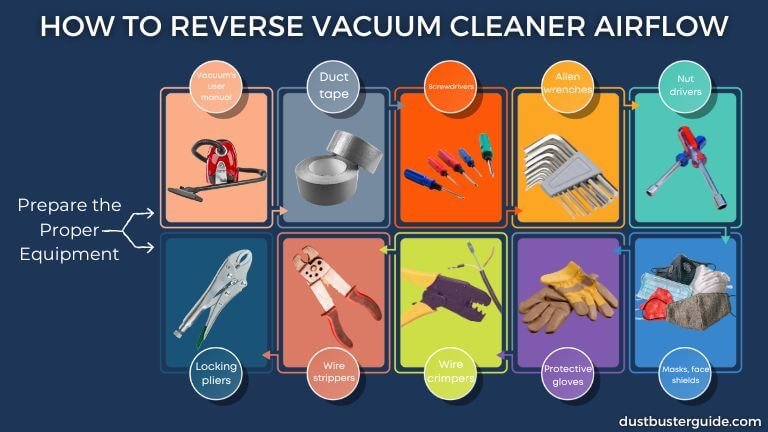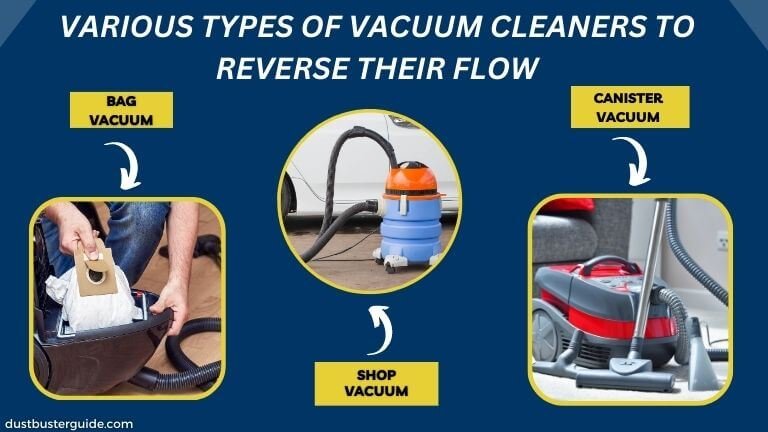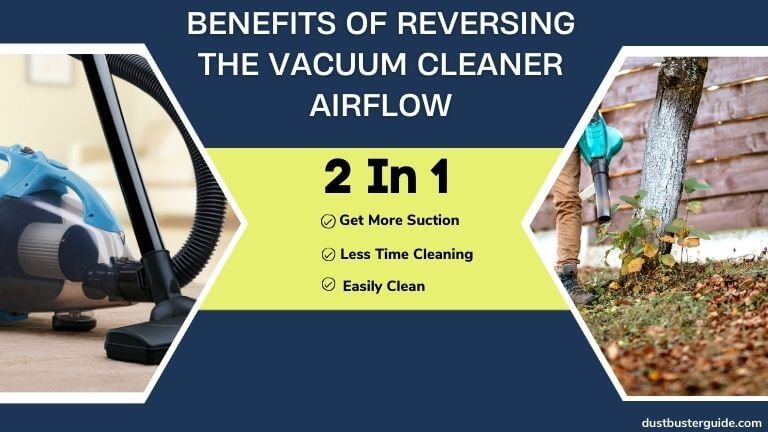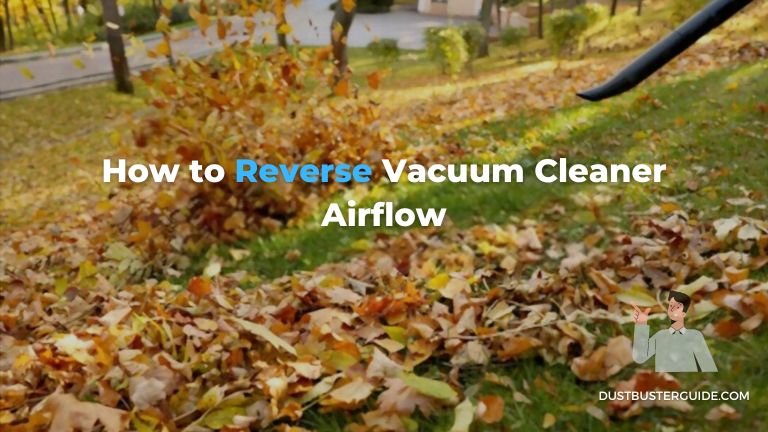Nothing is more calming than a tidy and comfortable environment, and a vacuum cleaner is always helpful in achieving this. We can see that all of you find vacuuming to be a hassle. However, vacuuming may be made much simpler and more effective by reversing vacuum cleaner airflow since it can remove dust and dirt from even the most difficult-to-reach areas.
Reversing the airflow of your vacuum cleaner to turn it into a blower can make your life even better and to achieve this, simply locate the air intake on your vacuum cleaner and attach the hose to it, turning the machine into a powerful blower.
Not only does this method enhance your cleaning capabilities, but it also provides a cost-effective solution for an air purifier.
Below we will give you the complete details on how to reverse vacuum cleaner airflow. So get ready as we demonstrate the most effortless procedures to reverse the airflow of your vacuum cleaner. Let’s plunge in together.
How To Reverse Vacuum Cleaner Airflow – 5 Steps
Fortunately, below we have explained how to reverse the airflow of a standard one-way vacuum to make it a dual-purpose blower. Doing this will allow you to use your vacuum for many tasks and save money by avoiding purchasing multiple tools and machines.
- Determine what type of vacuum you have
- Prepare the proper equipment
- Use all safety precautions
- Reversing the vacuum cleaner’s airflow
- Testing your vacuum cleaner as a blower
Determine What Type Of Vacuum You Have
Before taking any action, you must first determine the type of vacuum cleaner you own so that you have clear guidance on how to reverse vacuum cleaner airflow for that particular model. So know what procedure goes best for a respective vacuum cleaner. Of course, you may change the direction of your vacuum’s airflow. However, only some of them might be appropriate for the procedure; therefore, we suggest you be better aware of the vacuum you use.
Canister vacuums and bag vacuums are the ideal sorts of vacuum cleaners to reverse into blowers, according to our experience, even though there are many other types of vacuum cleaners. Today, the majority of household vacuum cleaners don’t utilize bags. Instead, they feature plastic cylinders with filters attached.
You can convert older vacuum cleaners into temporary blowers if you have any. On the other hand, you can also make blowers quickly from shop vacs, plastic canister-style vacuums, and bag vacuums by reversing their airflow.
Prepare The Proper Equipment

You must be prepared and have all the necessary tools by your side for reversing your vacuum cleaner’s airflow. Since we think of man as a tool-using animal, he is nothing without an instrument and everything when he has one.
For this particular task, you’ll need the following tools:
- Vacuum’s user manual
- Duct tape
- Screwdrivers,
- Allen wrenches
- Nut drivers
- Locking pliers
- Wire strippers
- Wire crimpers
- Protective gloves
- Face shields/masks, etc.
You can search for it online if you can’t locate a copy of your vacuum’s user manual. Before you begin, carefully read the directions for disassembling the cleaning device. You can become familiar with the location of particular components in this way.
Additionally, you’ll need channel lock pliers or adjustable wrenches to remove the vacuum cleaner’s filters. After removing the filter, you will need a drill and various-sized bits to remove the remaining screws.
Use All Safety Precautions
It’s time to put on your gloves and face shield because you already have them ready while working on your vacuum cleaner.
Another precautionary measure is unplugging your vacuum cleaner before disassembling it to avoid electrocution. Additionally, by doing this, you can prevent accidentally starting your vacuum while working on something and spreading dust all over the house. Further, be extra careful to keep all minor parts intact since most vacuums have many.
Identify the airflow, if necessary, before disassembling your vacuum. Ensure your cord is far from water because you might use your blower outside and don’t want to risk electrocution or short-circuiting. Always be conscious of the location of the cord. When taking apart your vacuum, be careful not to nick or damage the power cable.
Reversing The Vacuum Cleaner’s Airflow
We see you are ready to do some serious work now, so let the war begin. Here is where your actual work starts: reversing your vacuum cleaner’s airflow. Once you have hung your vacuum, it’s time to switch the direction of its airflow. Attaching the hose (or blower nozzle) at the opposite end from where you typically connect is the simplest way to accomplish this. That will cause suction to defy gravity and work against it. Then remove any obstruction-causing filters and secure them with screws.
As we have discussed, there are various types of vacuum cleaners and multiple ways to reverse their flow. So let us see their procedure one by one:

Bag Vacuum
You must follow the steps below after unplugging the vacuum and familiarising yourself with the instructions and parts:
- Unzip the vacuum bag
- Remove the inner vacuum bag from the appliance’s intake hole, where it is attached
- Turn on the vacuum cleaner
- Allow as much dirt, dust, or debris to be expelled by the instrument as you can
- To release the accumulation, gently shake the vacuum
- The vacuum tube must be firmly sealed and fastened to the intake opening
Canister Vacuum
The vacuum has two main areas for airflow: the bottom hole, which gathers dirt and debris, and the vacuum’s opposite end, which blows air into a container or collection bag.
- Switch off the vacuum
- Remove the hose’s filter at the end that collects dirt, debris, or dust
- Take the vacuum outside
- Restart the appliance
- To remove particles, let the vacuum run for several minutes
- The vacuum will act as a blower once you have removed the accumulation
Shop Vacuum
The simple procedures to reverse shop vac airflow are as follows:
- Switch off the vacuum
- By unlatching, turning, or drawing the clamp straight out, remove the flexible hose
- The opposite end of the vacuum should have its exhaust cap removed
- After removing the exhaust cap, re-insert the flexible hose into the opening
Testing Your Vacuum Cleaner As A Blower
We are all aware that the last step is just testing our work to determine our level of success. Connect it to determine whether your vacuum is operating correctly after reversing the airflow. Turn on the switch and any attached power equipment, such as sanders or routers, if necessary. After testing, your vacuum cleaner is ready for use once you have connected all filters and screws. And yes! your house is prepared to be thoroughly cleaned and gleaming.
How To Use The Vacuum Cleaner As A Leaf Blower – 3 Steps
While they are still on the trees, autumn leaves are beautiful. But once they are piled up in corners around your house, dense in your flower beds, and on your lawn, you must remove them before they become a matted mess.
The idea of a one-tool solution for blowing and bagging applies to leaf blowers with a built-in vacuum function, whether you’re stirring up oak leaves in the fall or magnolia petals in the spring. And don’t worry if you don’t have a specialized leaf blower; we covered you. You can continue using your vacuum cleaner to complete the task. Here is a guide that will show you how to use your vacuum cleaner as a leaf blower:
Step 1
Disconnect the vacuum’s motor unit from the collection tubs to guarantee safety.
Step 2
The next step is to detach the vacuum suction pipe and change it to the blowing side.
Step 3
Start the vacuum and point it toward the surfaces you want to clean. The hose releases a strong air stream that quickly removes the leaves, dust, and other debris. This function benefits the lawn because it is difficult to clean up the dirt in that region.
| Steps To Use Vacuum Cleaner As A Leaf Blower |
|---|
| Step 1 |
| Disconnect the motor unit of the vacuum from the collection containers to ensure safety. |
| Step 2 |
| Remove the vacuum’s suction pipe and switch it to the blowing mode. |
| Step 3 |
| Start the vacuum and direct it towards the desired cleaning areas. The hose emits a powerful airflow that swiftly clears leaves, dust, and debris. This feature is particularly useful for tidying up lawns, where dirt can be challenging to handle. |
Benefits Of Reversing The Vacuum Cleaner Airflow

Reversing the airflow of your vacuum cleaner provides you with many benefits, which we have described below:
With the ability to reach every corner in your apartment or house thanks to reverse vacuum cleaner airflow, you can spend less time cleaning and more time enjoying yourself.
You can also get more suction by employing reverse vacuum cleaner airflow. You ensure that you have swiftly and effectively cleaned up the dirt, dust, and debris.
You can easily clean your computer, laptop, and other electrical supplies and furniture by reversing the airflow direction.
For more thorough cleaning, use a vacuum cleaner and a blower as a dual-purpose cleaning solution.
Instead of tossing away your old vacuum, you can modify it to use it as a leaf blower.
Reversing the airflow of your vacuum cleaner can serve as an air purifier. Therefore, flip that sucker around and let those potent suction forces do their magic if your allergies are acting up or there is pollen everywhere. Later, you’ll thank us.
How To Reverse A Vacuum Cleaner To Inflate
To reverse a vacuum cleaner for inflating purposes, you’ll want to follow these steps carefully.
First and foremost, prioritize safety by ensuring the vacuum cleaner is completely unplugged and turned off. Next, locate the exhaust port on your vacuum cleaner, typically found at the back or side of the machine. This is where the vacuum expels air, and it’s crucial for the modification.
If your vacuum cleaner comes with detachable attachments, like a hose or extension wand, it’s a good idea to remove them as they will be essential for the inflating process. With these attachments, you can channel the airflow in the desired direction.
To complete the transformation, seal off the suction end of the vacuum cleaner. This is usually where the vacuum head or nozzle is located. You can effectively block it by taping it shut or attaching a piece of cloth or cardboard and securing it with a rubber band.
Lastly, attach the hose or extension wand to the vacuum cleaner’s exhaust port. Make sure it fits securely to create a closed system, redirecting the vacuum’s airflow in the opposite direction. With these modifications in place, your vacuum cleaner is now ready to inflate items like air mattresses, and pool floats, or remove dust from tricky spaces effectively.
Conclusion
So, get ready to have a cleaner house than ever, as now you fully comprehend how to reverse vacuum cleaner airflow. And voila! Turning it into a leaf blower gives you an additional bonus. Identifying the type of vacuum cleaner before you begin the procedure and reading through your vacuum’s instruction manual is great to practice, as knowing the ins and outs of your vacuum cleaner will be beneficial. Moreover, remember to have all the essential tools and precautions by your side. So why are you still waiting? Grab your tools, put the mask on, and let the job begin.
FAQs
Can I use my vacuum as a blower?
By switching the airflow of your standard or canister vacuum, you may utilize it as a blower. Faster cleaning and the increased air pressure inside the machine are both benefits of this method. We do not advise using this method for routine use, so read the instructions carefully before beginning.
Can I turn the shop vac into a blower?
You can rapidly convert your shop vac into a blower by installing a reverse airflow system. You can increase your vacuum’s strength by making this specific change, enabling you to utilize it for additional chores like blowing debris or leaves off furniture.
Why is my vacuum cleaner blowing out air?
Checking the dust collection is one of the most straightforward fixes for vacuum-blowing air. It is typically present near the vacuum cleaner’s base. You’ll need to disassemble it and clean it if it’s clogged with dirt, hair, or pet fur. The filter may also need to be changed if it is unclean.
Does vacuuming backward work?
As you work, move the vacuum cleaner across the floor in forward and backward motions. It enables any debris in the carpet fibers to become loose due to vibrations from the equipment, allowing you to pick up the dirt when your vacuum goes over the area again.
What replaces the air in a vacuum?
In a vacuum, air is replaced by the absence of matter or the near-complete absence of gas molecules, creating a low-pressure environment.
Why don’t vacuum cleaners have a “reverse” function?
Vacuum cleaners lack a “reverse” function because their design focuses on sucking in debris rather than expelling it, making a reverse function unnecessary for their primary cleaning purpose.
External Resources
- Sir James Dyson Wins Vacuum Cleaners Appeal At European Court – BBC
- Effectiveness Of Do-It-Yourself Vacuum Cleaner To Minimize Dust Problem By Bestlink College of the Philippines
- LADYBIRD: The Animal-Friendly Robot Vacuum Cleaner – AAAI
- Multifunction Vacuum Cleaning Robots Market Research Analysis With Types, Applications And Growth Production Analysis With Top Players – Digital Journal

